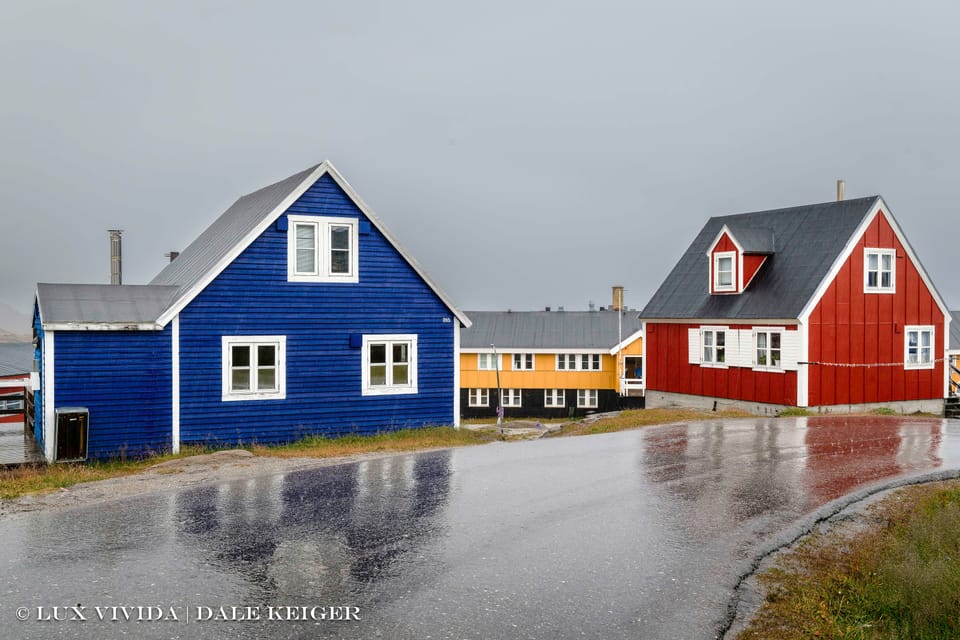More than meets the eye, more than meets the camera sensor

Tasiilaq, Greenland began in 1894 as a Danish trading post called Angmagssalik. Danes had been in and out of Greenland for quite a while, starting with Erik the Red and some furry Viking settlers in the 10th century. Beginning in the 1700s, Denmark put more effort into claiming the island as a colony, but history suggests they didn’t exactly exert themselves. There were missionaries, of course, and some trade in whale blubber, sealskins, and narwhal tusks, but Greenland had little arable land, few inhabitants, and little potential but for whaling and cod fishing. Denmark didn’t need a frozen island four times the size of France for that. Especially one that was 80 percent crushed by a massive ice sheet that pressed the bedrock hundreds of meters toward the earth’s core.
According to the Visit Greenland website, Tasiilaq means “the town with the seawater that looks like a lake.” (Seems like a lot of information for only eight letters, but you have to admire the economy, plus the story’s too good to fact-check. Imagine what “Angmagssalik” must mean.) The seawater is King Oscar Sound and Tasiilaq is now East Greenland’s largest town, not that there’s much competition. The whole of the populated east contains only ~6,000 inhabitants. Around 1,900 of them live in Tasiilaq, mostly Inuit Greenlanders with a sprinkling of Danes and other Europeans who find it agreeable to live there.
The town with the seawater that looks like a lake was built on a rockpile. The most expansive planar surface in town is the soccer pitch. Tasiilaq’s houses are anchored to the boulders in such a jumble that no three seem built on the same level. It is as if each Tasiilaqian at some point gazed at a tabletop rock and thought, I know, I’ll put a house there. And then I will paint it a very bright color.


Greenland—Kalaallit Nunaat to Greenlandic citizens—rules itself, mostly, as “a self-governing overseas administrative division of Denmark.” It’s also, like the Faroe Islands, a constituent of the Kingdom of Denmark (which is presided over by a queen…never mind). Two-thirds of Greenlanders have stated they want to be fully independent by 2040, and good for them. But as the ice sheet recedes enough to permit oil exploration and lithium extraction, you can bet your ass the jackals will be circling. The locals have a fight coming.
Before Scandinavians began importing wooden house kits in the 18th century, Greenlanders lived in sod dugouts or huts made of stone and peat. There were no alternatives—Greenland had no forests. During warmer months, they lived in tents.

Denmark prefers to recast itself as a peaceful, benevolent colonizer. It’s true that the Danes didn’t subject the Inuit to the pervasive violence and brutality that made Europeans so popular throughout the globe for centuries. But they were typically callous toward Greenlandic culture. In the latter half of the 20th century they pushed much of the population into a modern labor economy that the Inuit hadn’t asked for, imposed Western education on Inuit children, and left many nomadic hunters with little choice but to relocate to a dozen or so towns. The collateral damage included rising rates of alcoholism and suicide. This is a familiar story.
View all those cute wooden cottages as emblematic of Greenland’s forced modernization and you’ll find an irony in all the lively paint jobs. Tasiilaq grew into a full town without street addresses because Greenlandic settlements didn’t have streets. Everyone knew where everyone else lived anyway, so who needed addresses on an urban grid?
Apparently, the Danes found this sort of infrastructural disorganization discomfiting, for they came up with a color code to help anyone new in town navigate. Churches, schools, trade buildings, and teachers’ houses would be painted red. Yellow was reserved for health care—clinics and the houses of doctors or nurses. If you worked with tools as a mechanic or someone in telecommunications or power generation, you lived in a green house. Blue houses were for fishermen. Police stations were black.

These stipulations no longer obtain, though clinics are still painted yellow. Now Greenlanders daub their houses in whatever Crayola color they like. There’s a popular general theory, at least on the internet, that fishing communities like Taliisaq, that front misty oceans, began painting their waterfront structures in vivid colors to help fishermen find them in the fog. I've experienced fog in places known for their colorful shorefront houses, like Greenland and Newfoundland, and I’m dubious. You can’t see anything in that soup, no matter the color, and I wonder when was the last time someone asked an actual fisherman about the theory.

Greenland is not a prosperous country, so Greenlanders do not regularly repaint their houses. The harsh climate goes to work on every painted surface. That’s okay. The weathered exteriors are like memory: faded compared to the bright surface of a present moment, but rich in texture, a record of bitter cold and unrelenting rain and time’s passage. What once was uniformly blue or red or yellow is now seasoned and complex and enduring. The paint has stories to tell.

Tasiilaq photographs well in damp air. Water droplets dissipate glare and reflection and saturate the colors. I felt an urge to make a picture of every house in town, which would have been doable in a day. I didn’t because the natural landscape beckoned, with its rocks and glaciers and icebergs, and I had a boat to catch. But if I ever go back, I might complete that chromatic survey, just to amuse my eyes and add all that rich color memory to my own memory.

More songs in the same key:
Member discussion